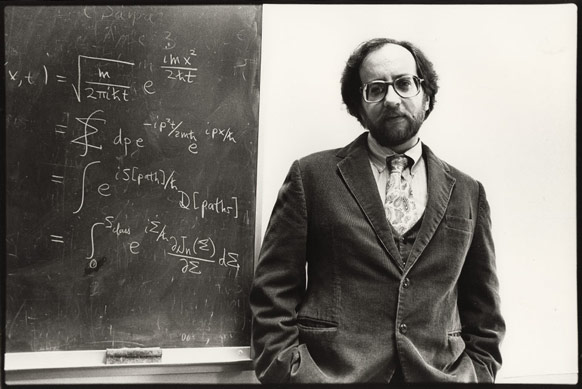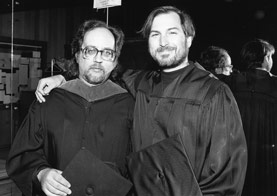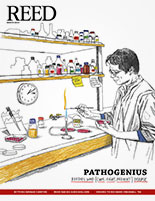
IRIS login | Reed College home Volume 92, No. 1: March 2013
In Memoriam
The Experimental Polymath

Chalkboard wizard. Professor Richard Crandall ’69 knew how to cut through a tangle of equations to the root of the problem.
Professor Richard E. Crandall ’69 [physics 1978–2012]
Portland, December 20, 2012, from complications of acute myeloid leukemia.
By Chris Lydgate ’90

Crandall arm-in-arm with Steve Jobs ’76 at convocation in 1991, when Jobs was honored with the Vollum Award.
Richard Crandall defied categories. He was a professor, a physicist, a computer scientist, and an inventor, but none of these labels convey the scope or the depth of his intellectual accomplishments. From the rings of Saturn to the hunt for prime numbers to the circuitry of the iPhone, there was no limit to his curiosity—or to his appetite for discovery. He held 11 patents, authored seven books, and wrote scores of scholarly articles on a vast range of subjects, but his signal achievements probably lay in experimental mathematics—an emerging field he helped to define.
“Richard’s mind operated at a level beyond the ordinary,” says his former colleague Nicholas Wheeler ’55 [physics 1963–2010]. “He sparkled with swift, reckless, eccentric ideas of every kind.”
Richard was born in Ann Arbor, Michigan, and grew up in Los Angeles. Part Cherokee, he was proud of his Native heritage. His formidable intellect became apparent at an early age; he read Time magazine to his kindergarten classmates during mat time and taught himself calculus at the age of 11. He spent two years at Caltech, attending lectures by Richard Feynman, before coming to Reed in 1967. He loved Reed and often talked of his student days as the most glorious time of his life. He majored in physics and wrote a thesis on some physical manifestations of randomness with Wheeler. In April of his senior year, he made a terrible confession—he had lost his thesis draft at the Lutz Tavern. “He wasn’t terribly concerned,” Wheeler remembers. Always a fast worker, Richard simply rewrote his thesis from scratch and graduated on time. After passing his orals, he revealed that he had also (unbeknownst to anyone) written a second thesis in math, which was approved by John Leadley [mathematics 1956–93].
After Reed, Richard went to MIT, where he worked with the theoretical physicist Victor Weisskopf, renowned for his ability to construct back-of-the-envelope estimates based on deft physical insight. From time to time Richard would return to Reed (by train—he hated flying) to recharge his batteries. “We’d work day and night for a couple of weeks on some problem,” Wheeler says. “Then he’d walk me home and we’d stand under a streetlight talking physics until two a.m.” After earning his PhD in theoretical physics from MIT in 1973, Richard designed fire safety and energy control systems for skyscrapers. He was interviewed in People magazine after the blockbuster Towering Inferno about the safety of modern high-rise buildings; the accompanying photograph showed him in elegant pin-stripe suit, vest, and untied tennis shoes.
In 1978, Richard returned to Reed in the physics department as visiting experimentalist. He was skilled at constructing fundamental experiments on a shoestring budget (one of his favorite tricks involved demonstrating the Doppler shift in visible light using a couple of old stereo speakers). “Richard was brilliant, intimidating, infectious, and very generous,” wrote Berkeley physicist Ed Wishnow ’80. “He was a very big influence on me and he introduced me to the fun of experimental
physics. We also spent quite a few nights with lasers and mirrors (‘borrowing’ them from the bathroom) in the physics building hallway trying to measure the
speed of light.”
Another project involved teaching students to design and build a system to transmit computer data from the physics lab to Eliot Hall by means of a laser beam. “It was late one night the first time we succeeded in modulating an ASCII bit stream onto the laser, transmitting it from one end to the other of the second floor hallway of the physics building, focusing it, detecting it, demodulating it, and playing it back on a monitor,” wrote Chris Ruf ’82, now director of the Space Physics Research Laboratory at the University of Michigan. “I remember that Richard giggled when it started to work. A couple of months later, the link was installed between physics and Eliot Hall.” The link was an integral part of Reed’s computer network for many years, although intrepid physics majors periodically had to clip branches from the cherry trees in Eliot Circle lest they interfere with the signal.
Richard’s abiding interest in music prompted him to build a series of amplifiers, effects boxes, and instruments, including an innovative (but heavy) keyboard synthesizer, dubbed the Albatross, that hung from his neck on a leather strap. He played guitar in several Reed bands, including Central Nervous System and the Chameleons. “I’m glad that, back then, we weren’t ashamed of our musical naivety, because our youth, our unbridled optimism, and our drive to have rollicking good fun made for a special time in our lives,” wrote band mate (now attorney) Connie Crooker ’69.
Around the same time, Richard was pursuing a line of thought that would ultimately shape his career: experimental mathematics. Like many physicists, he used computers to explore scientific problems. He wrote software to demonstrate how the gravitational force of Saturn’s moons produced the Cassini Division between its rings; to simulate logic circuits; to play billiards, chess, and poker. (Bonus feature: the program could bluff.) But Richard went further. Dissatisfied with the limitations of existing computer languages, he invented two of his own, Rascal and PSI. He possessed an uncanny ability to write algorithms to solve problems that arose in physics but were actually mathematical in nature.
Richard was a leading expert on prime numbers—numbers that cannot be produced by multiplying smaller numbers together; examples are 3, 17, 19, 61, 67, and so on. There are an infinite number of primes, but proceeding towards infinity they become harder and harder to find. Working with such gargantuan numbers, consisting of hundreds of thousands of digits, poses a monumental challenge. Standard computer software is simply not designed to handle numbers of this magnitude; even elementary operations such as addition and multiplication overflow conventional processors.
Thanks to his musical knowledge, Richard had a thoroughgoing command of signal analysis, the science of teasing out meaningful information from a vast quantity of data, such as identifying the crash of a hi-hat in a ZZ Top recording. He soon realized that an enormous number could be treated as a sort of signal; and that the techniques he invented to identify a cymbal in a rock tune could also be used to find factors in a colossal number. Armed with this insight, he wrote a trailblazing series of algorithms to search for primes; several dozen of the largest known primes were discovered using his methods. (These results have far-reaching significance because they can be used to create virtually unbreakable codes.)
In 1982, Richard struck up a random conversation in the coffeeshop with an alumnus who was talking about computers; this turned out to be Steve Jobs ’76. The two developed a long and productive working relationship. Over the years Richard held several positions at Apple, serving as chief cryptographer, distinguished scientist, and head of the Advanced Computation Group. His algorithms were employed in many of Steve’s legendary projects, including the Macintosh, the NeXT, Toy Story, and the iPhone. He organized Steve’s bachelor party in 1991, and, later that year, presented him with the Vollum Award at Reed’s convocation.
Richard pioneered the use of desktop computers at Reed. He founded the D-LAB, located in the physics building, in which students wrote software such as GriffinTerm, GriffinText, RASCAL, SuperChroma, and Modern Artist. He was especially keen on the use of computers in the liberal arts and a fervent advocate that computing could be a powerful tool for any discipline. “Richard just has this creative energy that couldn’t be suppressed,” says Marianne Colgrove ’84, who worked in the D-LAB. “He was full of inventive ideas, and refused to be bound by any single discipline.”
Richard married Tess Day in 1996 in the Eliot Hall chapel; Laurene Powell Jobs, Steve’s wife, served as “best man.” Their daughter, Ellen, was born the following year.
In the ’90s, Richard took an early retirement from full-time teaching to found and direct the Reed Center for Advanced Computation, where he employed many Reed students in various projects. In 1999, ending 200 years of speculation, the Reed team proved that the 24th Fermat number, a numeric behemoth consisting of five million digits, was not prime.
Richard continued to teach courses at Reed in scientific computation, work for Apple, write algorithms for his consulting firm, Perfectly Scientific, Inc., and pursue research, publishing scores of papers on subjects as varied as the geometry of the brain and the epidemiology of influenza. He also set up a publishing company, PSIPress, whose catalogue includes books by Marvin Levich [philosophy 1953–94], Julie O’Toole ’71, and Gina Collecchia ’09. He also purchased a print shop, Impress Printing, in NE Portland.
Richard maintained his share of professorial idiosyncrasy. He played blindfold chess, loathed doctor’s offices, and once hired a friend to drive him from Portland to Chicago rather than endure a visit to the airport. He kept a small plastic Christmas tree in his home all year round to save himself the trouble of setting it up for the season. Despite his gruff exterior, he was a legendary figure in the Woodstock neighborhood, where he could often be seen toting a stack of yellow legal pads crammed with equations written in an elegant longhand.
His final project was an “intellectual biography” of Steve Jobs. He was deeply immersed in it in December, when he collapsed at home and was rushed to the hospital, where he was diagnosed with acute myeloid leukemia. He died 10 days later, his great work unfinished.
“Richard was always imagining what might be possible, then, in his unique way, doggedly trying to build towards it,” wrote computer scientist Steven Wolfram, author of Mathematica. “Around the world at any time of day or night, millions of people are using their iPhones. And, unknown to them, somewhere inside, algorithms are running that one can imagine represent a little piece of the soul of that interesting and creative human being named Richard Crandall, now cast in the form of code.”
He is survived by his mother, Janice Veca; brothers Gary and Ronald; former wife, Tess; their daughter, Ellen; stepsons Forrest, Eric, and Leif; and nephew Devin Crandall. A memorial will be held on Saturday, January 26, at 2 p.m. in the Eliot Hall chapel.


LATEST COMMENTS
steve-jobs-1976 I knew Steve Jobs when he was on the second floor of Quincy. (Fall...
Utnapishtim - 2 weeks ago
Prof. Mason Drukman [political science 1964–70] This is gold, pure gold. God bless, Prof. Drukman.
puredog - 1 month ago
virginia-davis-1965 Such a good friend & compatriot in the day of Satyricon...
czarchasm - 4 months ago
John Peara Baba 1990 John died of a broken heart from losing his mom and then his...
kodachrome - 7 months ago
Carol Sawyer 1962 Who wrote this obit? I'm writing something about Carol Sawyer...
MsLaurie Pepper - 8 months ago
William W. Wissman MAT 1969 ...and THREE sisters. Sabra, the oldest, Mary, the middle, and...
riclf - 10 months ago